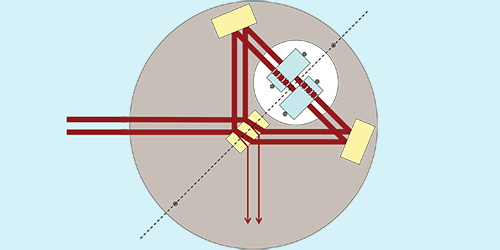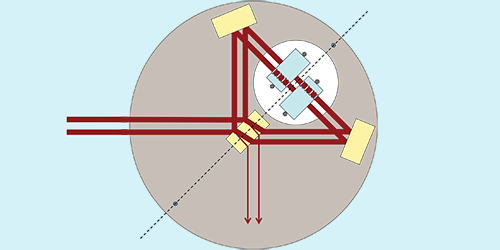Entangled Mirrors Could “Reflect” Quantum Gravity
Entanglement is a correlation between the quantum states of two objects, usually of microscopic size. But as a new theoretical analysis suggests, current technology could allow entanglement of mirrors weighing as much as 100 grams. The proposed experiment could help test quantum theories that attempt to include gravity.
It is not easy to tease out quantum behavior from large objects. One reason is that interactions with the environment destroy quantum correlations, and this decoherence is more significant for objects of greater size. Despite this, physicists have been able to demonstrate quantum effects, such as entanglement, in micrometer-sized oscillators cooled to near absolute zero.
Roman Schnabel of the University of Hamburg in Germany envisions pushing the quantum-size limit even further. In the setup, laser light propagating through an interferometer becomes entangled with the swinging motion of two suspended mirrors. This light-mirror entanglement can be transferred, or “swapped,” to a mirror-mirror entanglement by measuring the interference between the optical outputs. The idea is not new, but Schnabel has devised a novel interferometer geometry that is better tailored for producing entanglement. Rather than have the mirrors at the far end of perpendicular interferometric arms, he proposes that the mirrors be situated in a triangular configuration in which they reflect light beams from the front and back. This helps cancel out noise associated with laser fluctuations. The two mirrors are also placed right next to each other, opening up the possibility of probing the recent prediction that the mirrors’ mutual gravitational attraction should shorten the decoherence time of their quantum states.
This research is published in Physical Review A.
–Michael Schirber
Correction (24 August 2015): First paragraph: “…could test quantum gravity theories…” was changed to “…could test nonrelativistic quantum gravity theories…,” Second paragraph: “...could help test theories that attempt to unify quantum mechanics and gravity” was changed to “...could help test quantum theories that attempt to include gravity,” Last paragraph: “...possibility of probing certain models of quantum gravity that predict that the mirrors’ mutual gravitational attraction should shorten the decoherence time” was changed to “...possibility of probing the recent prediction that the mirrors’ mutual gravitational attraction should shorten the decoherence time of their quantum states.”





